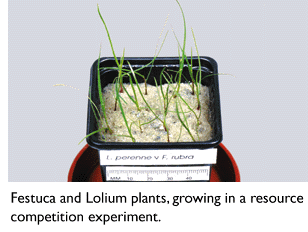 This page has been mothballed.
This page has been mothballed.
It is no longer being updated but we've left it here for reference.
Developing Conceptual Models of Resource

- Collaborator
- INRA, Lusigran, France
- Macaulay Contact
A conceptual model of resource acquisition and allocation within a generalized, individual plant growing vegetatively in competition with others has been developed in collaboration with INRA (Figure 1). The model considers carbon and nitrogen acquisition, synthesis of assimilates and their transport and partitioning, growth of new tissues, reserve formation and recycling, and losses due to root exudation and respiration. Based on our understanding of the physiology of these processes, the model allows for regulation of these processes by the relative size of the carbon and nitrogen substrate pools in shoots and roots, in relation to meristematic sink strength. Translocation and allocation patterns are represented in the model by the Minchin phloem transport model.
We have used the model to consider the impact of competition on resource acquisition and allocation first by considering a plant growing in isolation and in response to manipulation of light, CO2 and N supplies. Secondly, competitive plants were introduced and the direct effects on plant responses in terms of resource depletion considered separately from indirect effects such as potential changes in the quality of resources available (e.g. light quality or soil N sources). In the past, many studies of plant competition have not established the importance of these indirect effects because they have not established all the processes involved in competition. We can use the model to interpret responses of whole plants to their neighbours in terms of the relative importance of both direct and indirect effects of competition.
The initiative to develop this conceptual model arose out of the Twinning Agreement between the Macaulay and INRA and collaboration in research on plant competition in grazed swards. Complementary research studies exist between the Institute and INRA and the model has been developed to provide a mechanistic framework for designing joint programmes of research to utilise our complementary skills. In this way research results generated from experiments in France can be integrated with those from Scotland, enabling plant competition to be analysed in a wider context than would be possible for either organisation working in isolation.
Further developments
The model will be used increasingly to coordinate research between Macaulay and INRA scientists and be developed further by integrating components of the design into simulation models. This will enable us to coordinate research considering soil-plant-animal interactions and plant ecophysiology at the Institute with complementary research on plant photomorphogenesis and biochemistry within INRA. The model will also provide a framework for designing complementary experiments in France and Scotland and facilitate the exchange of ideas, development of simulation modelling and further collaboration.

